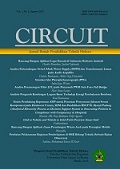Analisis Pengaruh Perubahan Posisi HAPS Terhadap Delay Handover Sistem Komunikasi Mobile Wimax
DOI:
https://doi.org/10.22373/crc.v1i2.771Keywords:
HAPS displacement, kecepatan user, delay HOAbstract
HAPS (High Altitude Platform Station), the infrastructure that is made to change BTS/BS, it could be one of solution to reduce cost and capacity problem. HAPS is like airship or aircraft that is placed on stratosphere line, the distance of platform is 17-22 km from earth surface. Because of that position, it’s affected by wind gusting, so that HAPS’s position can change from normal state that is called Platform Displacement. This research explain about the impacted of platform displacement to mobile station (MS) during HO process which is measured delay HO value. User is mobile wimax user who is doing communication using VoIP. Platform will be simulated in some position, horizontal position and vertical position, than MS moves on some speed, first, in medium speed is 50 Km/hour and 80 Km/hour, second high speed is 120 km/hour dan 200 km/hour. When platfor moves to the higher position will increase the coverage of cells, so each cell will interfere their neighbor. The effect of changing it position is perceived by user in transition area, this condition can disturb the HO process.Downloads
Published
2016-01-02
Issue
Section
Articles
License
Authors who publish in CIRCUIT: Jurnal Ilmiah Pendidikan Teknik Elektro agree to the following terms:
- Authors retain copyright and grant the journal right of first publication with the work licensed under a Creative Commons Attribution-ShareAlike 4.0 International License (CC BY-SA 4.0) that allows others to share and adapt the work with an acknowledgement of the authorship and initial publication in this journal
- Authors are able to enter into separate, additional contractual arrangements for the non-exclusive distribution of the journal's published version of the work (e.g., post it to an institutional repository or publish it in a book), with an acknowledgment of its initial publication in this journal.
- Authors are permitted and encouraged to post their work online (e.g., in institutional repositories or on their website) prior to and during the submission process, as it can lead to productive exchanges, as well as earlier and greater citation of published work. (See The Effect of Open Acces)

